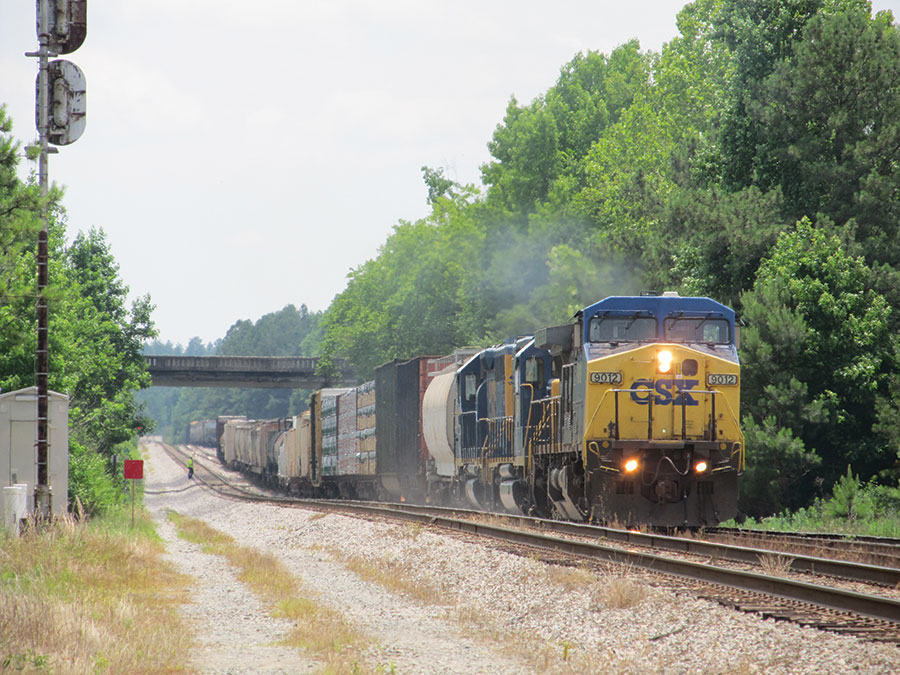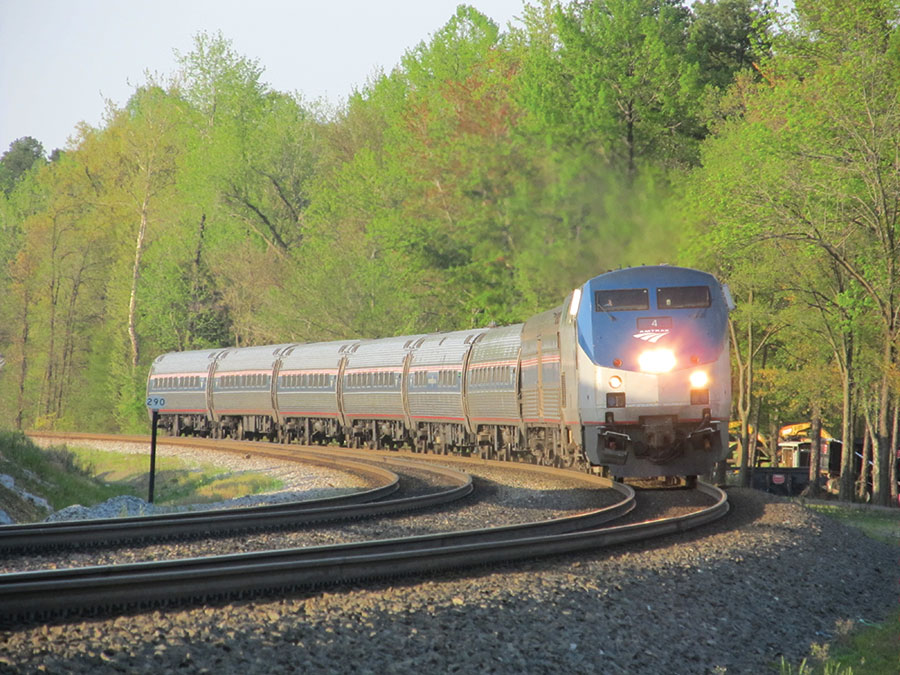
Train Spotting
Mike Small’s photographs capture the romance of the rails
By Billy Ingram • Photographs by Mike Small
The soundtrack of the South is in the music of the rails; horns like a hundred off-key saxophones serving as the chorus for a melody sung by wheels skating and skipping across iron. As singer songwriter Paul Simon once said, “There’s something about the sound of a train that’s very romantic and nostalgic and hopeful.”

Our city earned her nickname, “The Gate City,” because of our proximity to the railroad so it’s fitting that few American photographers have captured these mechanical age marvels in a more spectacular fashion than Greensboro’s own Mike Small. “I got into trains when I was a kid,” he tells me. “In the second or third grade I was drawing pictures of trains. Then I found out you can just take a photo, you don’t have to go to the trouble of doing the artwork.”
Mike started, well, small. “I got my first camera for Christmas in 1967,” he recalls. “It was a Polaroid Swinger, not a real quality camera. Almost all of my pictures taken with film were from a manual Canon FT. My current camera is a Canon PowerShot SX130, a high end point-and-shoot.”

He’s photographed just about every aspect of a train’s life here — switching freight cars at the yard in Aberdeen, a passenger line awaiting a crew change on a snowy day at the Pomona Yard, a Southern Railway southbound freighter crossing the trestle over the James River, an Amtrak Carolinian rounding the curve just north of the Hilltop Road crossing, even a rail line taken out of service in 1976 between Greensboro and Rural Hall in Stokesdale where the depot was moved and converted into a house.
Small’s dramatically staged photographs have appeared in numerous national magazines over the last 40 years or so. “I took lots of pictures of the Seaboard Air Line which merged with Atlantic Coast Line to form Seaboard Coast Line in the eastern part of the state. I liked the different color schemes,” he says of the line that dubbed itself the “Route of Courteous Service.” Small photographed one of those locomotives next to a restored former passenger station built in 1900 that today serves as a railroad museum in Hamlet.
In 2011, Small ventured back to where he grew up, near the tracks south of Thomasville, to snap an iconic photo of a locomotive chugging through fall foliage in the early morning hours, a freight train, he says, that ran from High Rock through High Point, Thomasville and Denton. “A milepost indicates 12 miles to High Point,” Small observes nostalgically.

Multiple people have told me of being in some far-away locale only to see the photographer whip by on his three-speed bike on his way to meet a train, camera in tow. “I spent a lot of time photographing Southern Railway’s Southern Crescent passenger trains which used to run through Greensboro in the 1970s,” he recalls. Of one memorable image he tells me, “Engineer Joe Beal is leaning from the window of the northbound Southern Crescent No. 2 in 1978, at the Greensboro passenger station.” An ice and sleet storm was underway so they were having trouble keeping the windshield frost-free: “That locomotive is a General Motors Electro-Motive Division E8A, built between 1949 and 1953,” he says enthusiastically.
Since 1970, Southern Railway’s fabled flagship passenger train the Southern Crescent traveled in both directions between New York and New Orleans, with stops in our nation’s capital, Atlanta, and our own downtown depot. “I remember the Southern Crescent E units, they called them, locomotives with the streamlined nose,” Small says. At some point in the night, on that 1,377-mile trip, the New York bound express and the Louisiana bound train could be expected to pass each other, but rarely in Greensboro.
That didn’t deter the shutterbug from lying in wait with lights and camera positioned just in case they converged here. “I didn’t know if I’d ever get that shot; I had to just keep watching for the southbound train to be sufficiently late so that it got here at the same time as the other one,” Small explains. Many nights he stalked the Greensboro depot hoping to capture both Southern Crescent passenger trains awaiting boarding at the same time, “I got the shot around 2:30 a.m. with thick fog in the air. That photo was published in Trains magazine in 1979, a calendar in 1984, and as a Vanishing Vistas print,” he says proudly.
In another chance Southern Crescent passing in the night, one shot in color, Mike notes, “The northbound No. 2 is at left and is on time. I lit the nose with a large press type flash bulb. Train No. 1, at right, was about an hour and 15 minutes late.”

Southern Railway (“Southern Railway Serves the South”) was famous for its polished handrails, plush wide seats, onboard chefs, attendents in starched uniforms fluffing white tablecloths in the club cars. That 1940s style attention to detail was no longer economically viable by the late-1970s.
Southern joined Amtrak much later than most other railroads, the last of the Southern Railway passenger trains were also the very last privately owned, long- distance passenger trains in the United States. The remaining freight lines were merged with Norfolk and Western in 1982 to become Norfolk Southern. “Some of the locomotives around here they keep rebuilding,” Small says. “They go back to the ’70s. Then you have the very modern ones, the ones with the wide nose. They’re not my favorites, though.”
In a photo taken from the Guilford College bridge at GTCC in Jamestown, a northbound Norfolk Southern train with double-stacked containers is seen powered by two Union Pacific locomotives. In recent years the railroad has added a second track between Greensboro and Jamestown.
Another colorful image depicts a Norfolk Southern container and trailer train snapped from the Cornwallis Drive bridge. It is, Mike Small points out, “The only place in Greensboro that I know of where a train can be photographed on the Washington and Atlanta mainline with the city skyline in the background.”
You can still ride the rails from Greensboro to the Gulf of Mexico aboard the Crescent. Many of its 1970s pre-Amtrak streamlined stainless steel-and-glass passenger and dining cars are still in use, with remodeled interiors, outfitted with modern conveniences. You’ll need to be at the downtown depot around midnight. Breakfast will be served as you pull out of Atlanta, luncheon on the other side of Birmingham.
Sure, some of the starch is out of the collars and the food is no longer prepared on board, but rail travel is one of the few rare, authentic travel experiences around — one that has changed so little it would be familiar to your grandparents.
It’s the only way to fly! OH
A frequent contributor to O.Henry, Billy Ingram prefers traveling by train..





